How to Cook and Freeze Whole Grains
How to cook and freeze whole grains including a handy whole grain cooking chart.

Also Read: Everything You Need to Know About Whole Grains, How to Cook Wheatberries, Wheat & Chickpea Greek Salad
How to Cook Whole Grains
For the most part, cook whole grains the same way you would cook rice.
Measure – Rinse – Add Water/Broth – Boil – Simmer
Measure, rinse, cover grain with water or broth in a pot, bring to boil, lower temp and simmer for specified time until grains are tender and liquid has been absorbed. That’s the general process.
There are of course exceptions – not all whole grains are cooked the same way – just like refined grains. For example you don’t cook cream of wheat the same way you would rice. The same thing is true for whole grains – some cooking processes depend on the recipe and how large or small the grain is.
Cooking Large Whole Grains
Large grains with thick hulls like wheat, rye, wild rice, brown rice, hulled barley, hulled oats and buckwheat do not absorb water as easily as white rice or the medium sized grains. That means they generally hold their shape – as in they don’t become a mushy porridge. Because they don’t absorb water, don’t be surprised if you have to drain off some of the water at the end of the cooking time. For these grains, judge the tenderness of the kernels rather than the amount of water left in the pot.
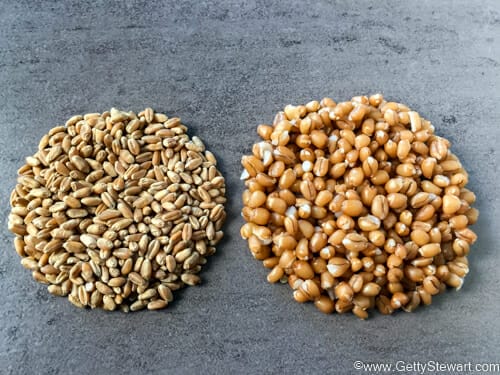
Cooking Small Whole Grains
Small grains like amaranth, teff and rolled oats absorb water easily. They thicken and become gelatinous in the cooking process. This makes them fantastic options for porridge or polenta. You can change the consistency by adding more or less liquid – more liquid will reduce the thickness of the final product.

Whole Grains Cooking Chart
Here’s a whole grain cooking chart for ease of reference. It’s the kind of thing you might want to print and tape to the inside of your cupboard or favorite recipe book. It gives a good overview of cooking the most common whole grains. Just remember, grains are organic and vary in thickness, humidity and so forth, so your batch of whole grains may take a little more or less cooking time to be as tender as you prefer.
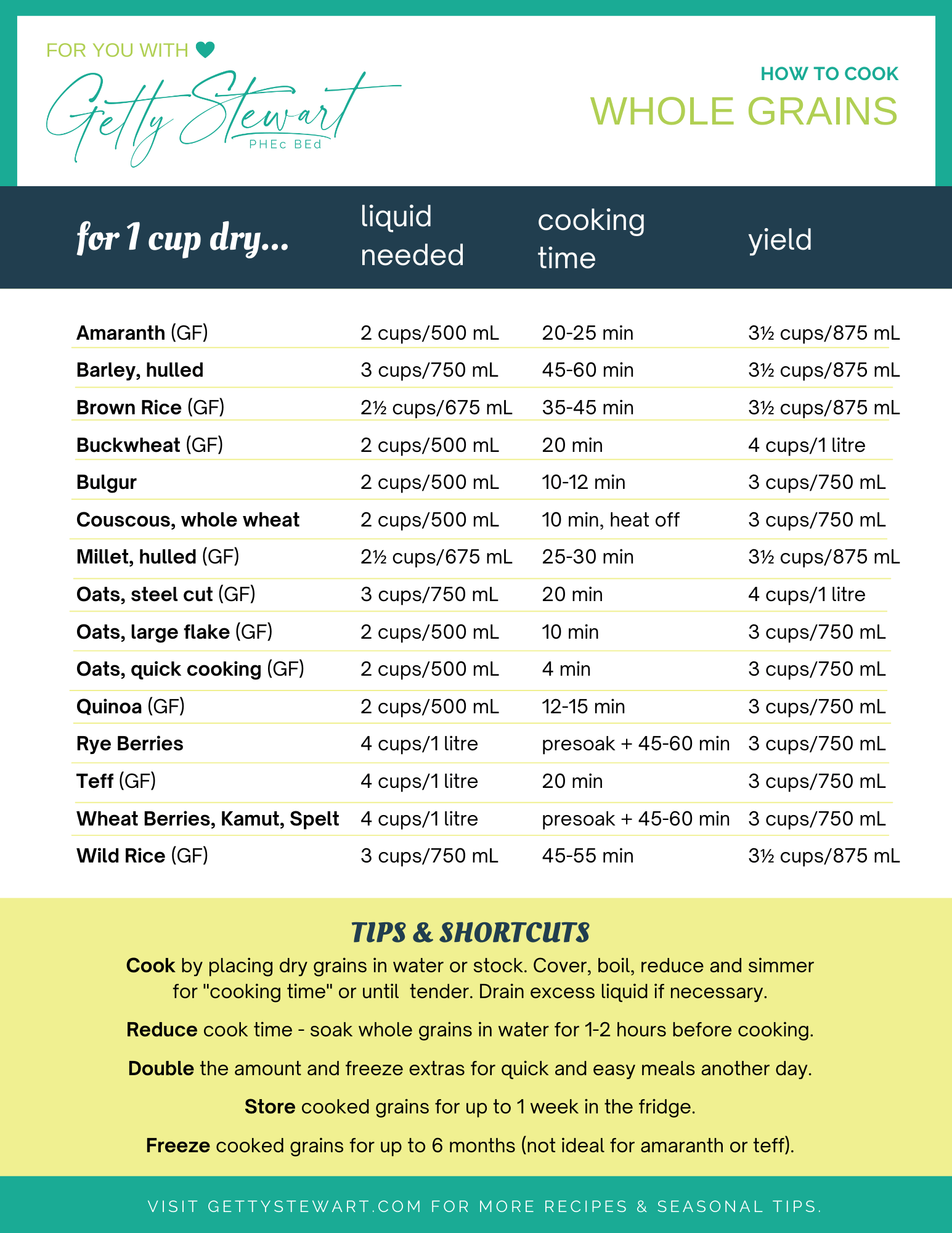
Click the Button to Get Your Copy
How Much To Cook – What’s a Serving Size
Whole grains swell when cooked, often they triple in size so 1 cup raw will give you 3 cups cooked. But this varies on the grain – see the last column in the whole grain cooking chart above.
As for serving size, 1/2 cup cooked whole grain is considered one serving. Start with this in mind and then add more or less per person based on you and your guests.
How to Freeze Whole Grains
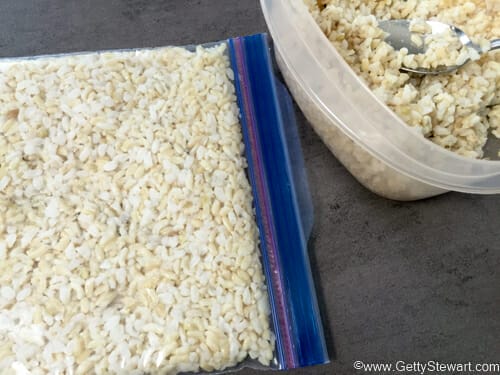
Except for the wee little grains like millet, amaranth and teff, you can freeze whole grains. It’s super easy and super smart.
There’s no denying that some whole grains like wheat, barley, brown rice, wild rice may take longer to cook than it takes to make the rest of the meal. But that’s no excuse for choosing refined grains instead. The solution is easy, make a double batch and freeze the extras to have quick and easy whole grains available at a moment’s notice. Even quick cooking grains like quinoa can be cooked and frozen.

I’ve been freezing brown rice for years and have never had any issues with texture or flavor. My latest experiments with buckwheat, wheatberries, quinoa and barley also showed me that there’s no noticeable difference in taste, texture or appearance when using frozen cooked grains.
To freeze, cool the cooked grain completely and totally. Yes, it really needs to be totally cold so trapped heat doesn’t condense and form ice crystals. Once cooled, fill a freezer container or a freezer bag. I like freezer bags because I can freeze them flat so they don’t take up much room in my freezer and they thaw quickly. And, if I just need a little bit of cooked grain for a soup – I can easily break off a piece.
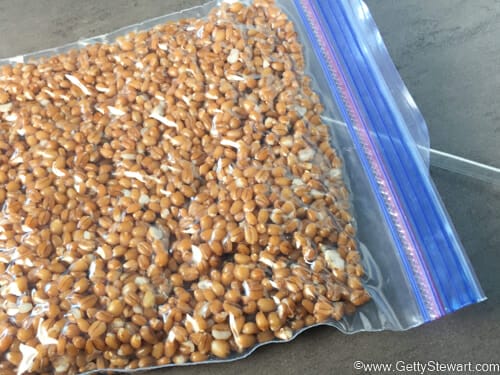
Notice the straw in the wheatberry photo. If I think I’ll be keeping something in the freezer for a long time, I use a straw to suck out as much air as possible from the bag. Removing air will help prevent freezer burn and improve storage time.
To thaw, I place the bag on a plate in the fridge overnight, or I open the bag and thaw on the defrost setting of the microwave. Another method for thawing is to place grains in a sieve and run cold water over them and let them drain.
More Info on Whole Grains
Want to know more about whole grains?
- Read Everything You Need to Know About Whole Grains. You’ll learn what whole grains are, why they’re beneficial, how to incorporate more whole grains into your diet, what is considered a serving of whole grains, why instant oats are considered whole grain and whole wheat flour isn’t, and so on.
- Book a Workshop to learn about, taste and create recipes using whole grains and seeds. I’ve done hands-on, interactive whole grains workshops in private kitchens, community kitchens and board rooms. Each one has been a great learning experience with tasty good fun. One of the activities is identifying various whole grains – how many of the following can you identify?
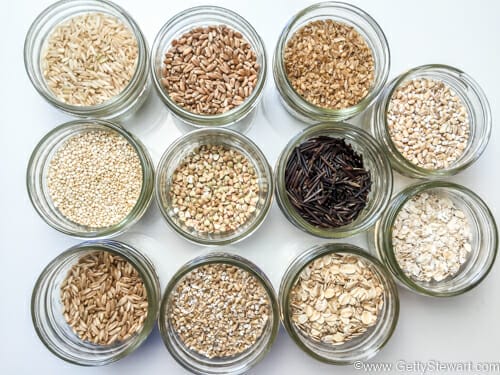
Whole Grain Recipes & Info
Here’s a list of recipes using whole grains that you’ll find on this site.
- How to Cook and Freeze Whole Grains
- Everything You Want to Know About Whole Grains
- Why Whole Wheat Doesn’t Mean Whole Grain in Canada
- Whole Grain Salad with Kale and Butternut Squash
- Pomegranate and Whole Grain Salad
- Orange and Wheat Salad
- Thai Power Bowl with Almond Butter Dressing
- Wheatberry and Saskatoon Salad
- Quinoa and Black Bean Salad
- Vegetable Quinoa and Red Lentil Soup Mix
- Parsley and Barley Salad– Tabbouleh
- Beef and Barley Soup
- Lime and Corn Quinoa (hot side dish)
- Brown and Wild Rice Pilaf
- Wild Rice Stuffed Acorn Squash
- Southern Beef ‘n Brown Rice
- Soup Mix in a Jar
- Homemade Granola
- Carrot Cake Granola
- Grapefruit and Granola Parfait
- Homemade Instant Oatmeal
- Rhubarb Overnight Oats
- Apple Pie Overnight Oats
- 50/50 Whole Wheat Bread
- 50/50 Whole Wheat Buns
- Nutty Cranberry Oat Muffins
- Chocolate Chip Oatmeal Cookies
- Coffee Lover’s Energy Bars
- Homemade Chocolate Energy Bars
I’d love to hear about your experience with whole grains and which ones you love and use the most. Share your recipes, leave a comment or tag me on your instagram photos #getgettys so I can see and like your creations.
Sign up to get articles by Getty delivered to your inbox. You’ll get recipes, practical tips and great food information like this. Getty is a Professional Home Economist, speaker and writer putting good food on tables and agendas. She is the author of Manitoba’s best-selling Prairie Fruit Cookbook, Founder of Fruit Share, a mom and veggie gardener.

